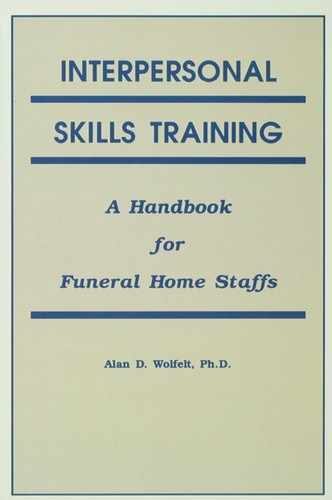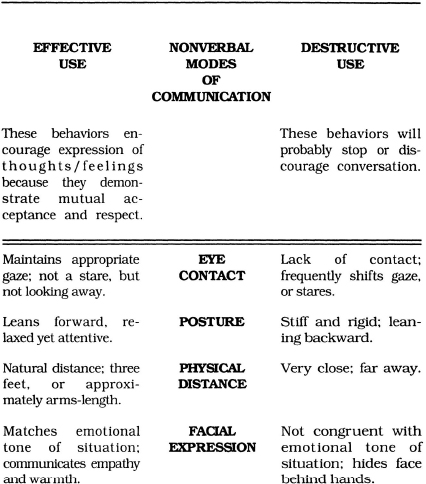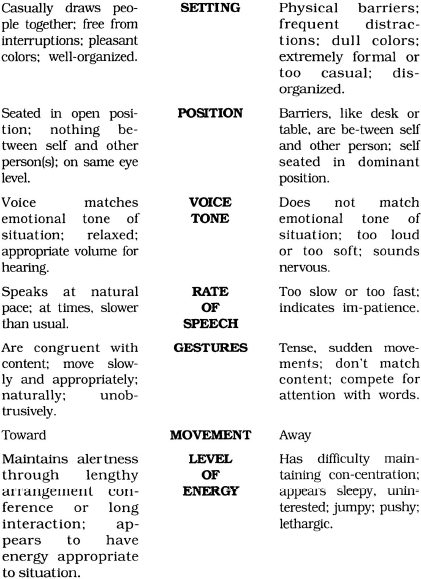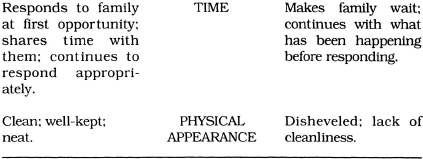SKILL ONE: ATTENDING OR LISTENING
a. Attending or listening is when the funeral director physically communicates interest or gives attention to the person.*
b. The funeral director gives the person undivided attention; by means of verbal and nonverbal behavior; he or she expresses a commitment to focus completely on the person.
c. Listening is the focus—listening for verbal as well as nonverbal clues.
In your role as a helping funeral director, you are often called upon to help either people you are currently serving or people you have served in the past. Learning how to listen effectively is an excellent means of putting your care into action. As you know from your own experiences, people need to be listened to and they sense others understand them.
As a funeral director you may be, and often are, one of the very few people who really listens to grieving family members. Even when people are surrounded by family and friends, they often are not really listened to. If you communicate your concern by being a good listener, you will have come a long way toward becoming a more effective and helping funeral director.
Personal Qualities of An Effective Listener
An effective listener has three personal qualities.
Desire. Perhaps the single most important characteristic of the good listener is desire. While this sounds simplistic, you need to want to listen. If you do not want to listen, chances are you will not listen. Through the process of listening you will be demonstrating your concern and acceptance of the person you are helping. Remember—people can quickly detect a superficial desire to listen.
Commitment. An effective listener not only needs to have a general desire to listen, but also needs to have a commitment to the task of listening. To be committed means to be responsible. If you are unable to talk at a particular time, be honest. Share your desire to talk and arrange for another time.
Patience. Combined with desire and commitment, the listening funeral director needs to have patience. Once you have made the decision to listen by involving yourself, take your time and patiently listen to the other person. If you are in a hurry and are anxious to get the situation “taken care of,” chances are that you will do a poor job of listening. Keep in mind that the experience of grief will vary in intensity and length with different people. Be patient and available to provide the understanding they seek from you as an effective listener. People often know what they can and cannot do about thoughts and feelings they express; however, what they need are patient listening ears.
Related to the quality of patience is learning that you do not have to try to fill every silence during the listening experience. There is a time for speaking and a time for silence. Sometimes in your effort to help, you may feel the need to keep the conversation going. Discipline yourself and remember: Listening also involves listening to the silent moments as the other person struggles to express a feeling or pauses to consider a thought.
So, by keeping in mind the importance of the qualities of desire, commitment, and patience, you are well on your way to becoming an even more effective listener!
2. IDENTIFY PURPOSES FOR USING THE SKILL
a. Attending communicates to the person that you are giving your undivided attention.
b. It communicates that you are trying to understand what they are saying. You are listening, and that behavior makes them aware of your concern.
3. ENHANCE UNDERSTANDING OF THE SKILL
We will review the following major components that play a part in attending or listening behaviors.
a. Eye Contact
b. Posture
c. Physical Distance
d. Facial Expression
e. Gesture
f. Setting
g. Voice Tone
h. Rate of Speech
i. Level of Energy
j. Physical Appearance
One of the easiest things to do when communicating is to focus on the content of what the other person is telling you. You hear the words that are spoken, and respond to them. Unless you apply yourself, you can easily be unaware of the wealth of information people communicate to you in nonverbal ways. When you learn that more than two-thirds of all communication takes place through nonverbal means, you can understand the importance of developing attending skills.
Attending skills are the physical behaviors you use while listening to another person. These behaviors—eye contact, posture, physical distance, facial expression, the general setting—convey messages to the families you serve whenever you are with them. (See Figure 6.1.)
Figure 6.1. Attending skills for funeral home staff.
Effective attending skills communicate that you are interested and concerned about the people you help at a time of death. If attending skills are ineffective, a helping relationship may not be established between you and those families you serve. This section will describe and assist you in developing attending skills as well as help you become more aware of the nonverbal communication of those around you.
No specific rules to follow are available in using attending skills. Some general principles, however, will help you use behaviors that are effective and avoid those that are ineffective. The guidelines for attending skills will allow you to express your uniqueness as a helping person when you are involved with people at a critical time in their lives. Also, keep in mind that cultural differences will influence the appropriate use of many of these components of attending.
Now let’s highlight several of the major components of attending.
Eye Contact. Perhaps the most effective way of making contact with people, especially shortly after a death, is through the use of your eyes. You attend to the person, or entire family, by looking at them and usually their eyes. This is a way of communicating your concern and interest in them; eyes are one of the key modes of communicating. While you certainly do not have to maintain a fixed stare, the appropriate procedure is to look at the people you are helping both while they are talking with you and during times of silence. Also, don’t ignore people who by their nature or current emotional state are very quiet. You still want to make eye contact with them to help them feel included and supported.
Posture. A second component of attending is posture. Each moment of every day, we communicate a great deal by how we stand, sit, and walk. Take a moment right now to become aware of your posture and what it might communicate to someone entering the room. When you are involved in a helping relationship, your posture can communicate an interest and readiness to assist. Also helpful is communicating a sense of relaxation with your posture as it can have an important calming effect on the individual or family you are aiding. If you are tense, you will take the focus away from others and put it on yourself.
Physical Distance. A third component of attending is the physical distance between you and the people you are helping. At times, an appropriate behavior is to move in very close as you reach out to comfort. (At first, of course, this would be somewhat dependent on your relationship with the family.) Use the other person’s reaction as a guide. If they pull away, take that as an indication that you are too close. We have found that most individuals and families are most comfortable at a distance of about three feet. You must take responsibility for seating yourself in the arrangement room, in the home, or other places in a position where you can communicate most effectively with all of those present.
Facial Expression. A fourth related component of attending is your facial expression. The expression on your face should match, as closely as possible, the emotional tone of what is occurring around you. Few people are more aware of the importance of this than those involved in funeral service. Your facial expressions can easily communicate a sense of warmth, as well as the message, “I am with you, I understand, and I want to help you.” You may find that you communicate something differently with your facial expression than you are aware. After all, to see your facial expression is difficult unless you look in a mirror. You might want to ask your family, friends, and co-workers how they perceive your different facial expressions.
Setting. A fifth attending element is the setting. Of course, at times you have little, if any, control over the setting. Your initial contact with the family (excluding the telephone) may be in their home, the hospital, or a nursing home. Within the funeral home, however, you have an opportunity to create a setting that is most conducive to effective helping. The arrangement room should be a place that affords the family your undivided attention. Interruption and distractions should be eliminated as much as possible.
Furniture can be arranged in a way that draws people together, as opposed to spreading them out. Pleasant colors can be used for both the furniture and the walls. Desks or tables often hinder the communication process. By doing away with the desk, you may be able to involve yourself with the family and better communicate your openness. Research has found that some people like to sit at a round table (like in a kitchen) because they are used to discussing problems around a table.
Essentially, different families have different preferred settings for communicating, and you need to be able to offer choices and adapt to their unique needs.
Gesture. A sixth component of attending is gesture. You communicate much with your body movements. Your gestures should be natural and not interfere with your intended communication. If you move quickly or have mannerisms that are distracting, you will take a great deal away from your ability to help. Ask yourself if the messages you give with your gestures are those that you intend to communicate.
In Figure 6.1 are listed a number of additional elements of communication and, in general terms, behaviors are described that may be either effective or destructive. You will want to review these different components of attending and consider your own use of them with families you serve.
Destructive attending behaviors tend to stop conversation or prohibit a helping relationship from being established. If you find yourself unable to attend effectively over a period of time, you will most likely notice some changes in the family’s behavior. They may become passive and have difficulty in sharing their hurt in a mutual relationship. The result is that you’ll probably move into a question/answer pattern difficult to get out of. On the other hand, they may become upset, impatient, and angry because you do not appear interested and concerned. These are signs that your attending skills are lacking and indicate that the person is not satisfied with the level of attention you are offering.
4. ILLUSTRATE USE OF ATTENDING
a. Trainer will illustrate this skill through demonstration because of the nonverbal component of the skill.
b. To aid in observing the illustration you are about to see, keep in mind: one easily recognizes when people are not listening; they are obviously engaged in another activity. Sometimes people also may be responding, but their nonverbal behavior says they are not with you. Be aware of what effect your attending has on people responding to you.
c. Trainer demonstrates this skill through structured role-play in front of group.
a. Makes it easier for you as funeral home staff member to listen and remember, especially when the person you are helping is in the initial phases of grief.
b. Gives both you and the person you are getting to know an opportunity to get to know each other. Often the person you are helping is not only in an emotional phase of shock and numbness; he or she is looking for help from someone unknown.
c. Gives permission to the person you are helping to express himself or herself because you are giving fully of your own energy, time, and attention. This helps build a good base for a relationship.
d. Furthers the goal of allowing the person to self-explore. By allowing the person or family to talk about what is important, you gather a tremendous amount of information without asking specific questions.
e. Communicates that you are trying to understand. You are listening and aware of the person’s concerns.
Trainer will do any additional role-play modeling to enhance the ease of learning for participants.
COMMUNICATING THROUGH ATTENDING SKILLS
Directions
Work in triads. One person (speaker) should talk freely for five minutes about any topic of interest. The second person (helper-listener) to whom he or she is speaking will listen, although he or she may ask questions or otherwise encourage the speaker to continue. The third person (observer-rater) will rate the helping funeral director (listener) on attending skills using the Observer’s Guide for Attending Skills (Form 6.1).
Expectations
The person in the helper-listener role should be able to demonstrate consistent use, as judged by the trainer and observer-rater, of effective attending skills in a five minute interaction.
Each member of the triad will rotate through each of the three roles: speaker, helper-listener, and observerrater. The observer-rater should be careful to give positive feedback first before citing areas that need improvement. Use the following guidelines for providing feedback for this and other break-out activities.
GENERAL GUIDELINES FOR PROVIDING FEEDBACK
“Feedback” in the context of this training is communication to a person for the purpose of providing to that person information about how he or she is progressing in the use of helping skills. Giving and receiving feedback is an excellent means of helping yourself and others refine the use of skills outlined in this manual. What follows are some specific guidelines to keep in mind when giving feedback to others.
1. Feedback is descriptive, not evaluative. By describing one’s own reaction, it leaves the individual free to use that reaction or not use it as he or she sees fit. By avoiding evaluative language, it reduces the need for the individual to react defensively.
2. Feedback is specific, not general. To be told that tone is “dominating” will probably not be as useful as being told “just now when we were talking about how to help during the arrangement conference you did not listen to what others said and I felt forced to accept your arguments or face attack from you.”
3. Feedback takes into account the needs of both the receiver and giver. Feedback can be destructive when it serves only our own needs and fails to consider the needs of the person on the receiving end.
4. Feedback is directed toward behavior about which the receiver can do something. Frustration is only increased when a person is reminded of some shortcoming over which he or she has no control.
5. Feedback is solicited, rather than imposed. Feedback is most useful when the receiver has formulated the kind of question which the observer can answer.
6. Feedback is well-timed. In general, feedback is most useful at the earliest opportunity after the given behavior (depending, of course, on the person’s readiness to hear it, availability of support form others, etc.).
7. Feedback is checked to ensure clear communication. Have the receiver try to rephrase the feedback he or she has received to see if it corresponds to what the sender has in mind.
8. Feedback is checked with others in the group. Is this one person’s impression or an impression shared by others? Both giver and receiver have a responsibility and obligation to check the accuracy of the feedback with others in the group.
7. SUMMARIZE AND LIST GUIDELINES FOR THE SKILL
8. NOTES OR QUESTIONS YOU HAVE FOR THE TRAINER RELATED TO THIS SKILL
OBSERVER’S GUIDE FOR ATTENDING SKILLS
| Rate the following behaviors: | 0 = did not occur |
| 1 = occurred but needs improvement | |
| 2 = occurred adequately | |
| 3 = helper especially strong on this point |
Nonverbal Behaviors
1. The helper maintained eye contact with the speaker.
0 1 2 3
Note:
2. The helper varied facial expressions during the interview.
0 1 2 3
Note:
3. The helper responded to the speaker with alertness and facial animation.
0 1 2 3
Note:
4. The helper sometimes nodded his or her head.
0 1 2 3
Note:
5. The helper had a relaxed body position.
0 1 2 3
Note:
6. The helper leaned toward the speaker to give encouragement.
0 1 2 3
Note:
7. The helper’s voice pitch varied when talking.
0 1 2 3
Note:
8. The helper’s voice was easily heard by the speaker.
0 1 2 3
Note:
9. Sometimes the helper used one-word comments such as “mm-mm” or “uh-uh” to encourage the speaker.
0 1 2 3
Note:
10. The helper communicated warmth, concern, and empathy through his or her facial expressions and other gestures.
0 1 2 3
Note:
*NOTE* The word “person” is used throughout this book. However, the word “family” could also frequently be used since you may be helping a number of persons.



